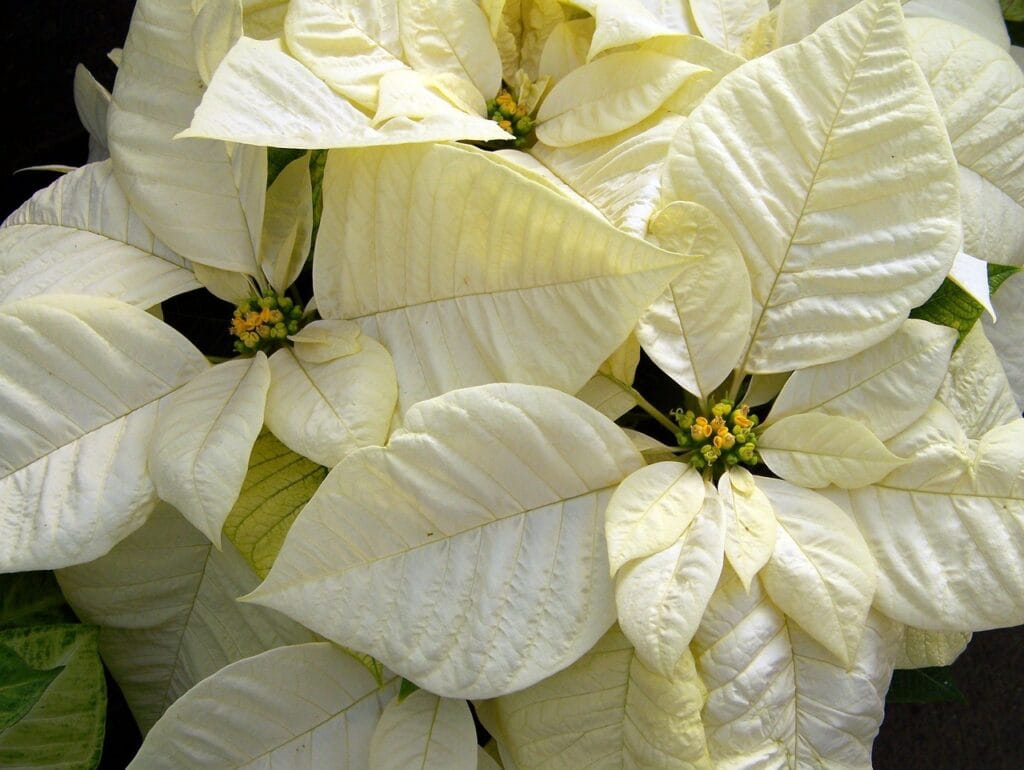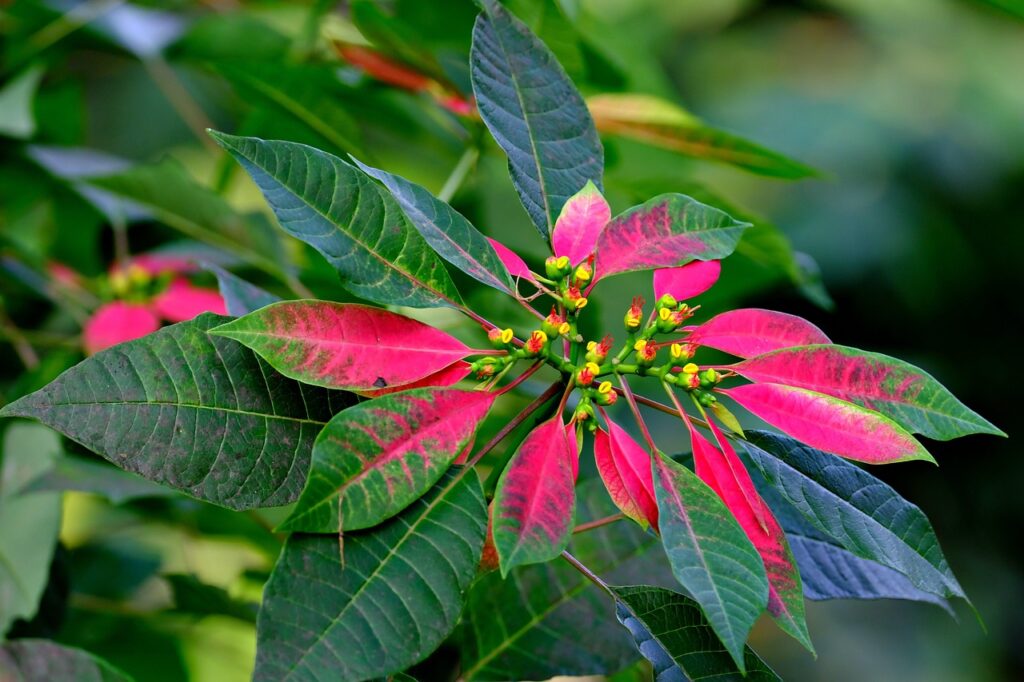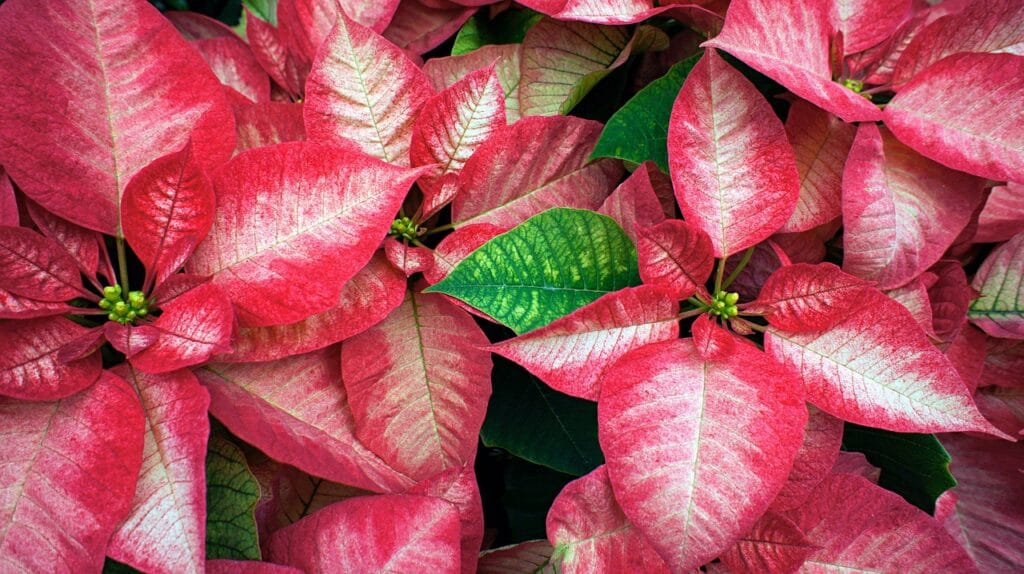Poinsettias are everywhere when the holidays roll in, right? But once January hits, most people just let them die—or worse, toss them out.
What a waste.
The thing is, learning how to care for poinsettias isn’t hard, and when you do it right, these plants can stay beautiful long after the decorations come down.
In this post, we’ll walk you through everything you need to know to keep your poinsettia healthy and vibrant year-round.
We’re talking about the basics—like how much water it actually needs (spoiler: not a ton), where to put it in your house, and what to do when the red bracts fade. You’ll also learn how to prune, repot, and even get it to bloom again next holiday season.
By the end of this guide, you’ll know exactly what to do to keep your poinsettia alive and thriving—inside, outside, and all year.
Stick around. You might be surprised at just how tough and rewarding this festive plant can be.
Understanding Poinsettias
Before you dive into plant care mode, it helps to know what you’re dealing with.
Poinsettias (yep, the ones with the red and green holiday vibes) are native to Mexico and Central America. Down there, they grow like shrubs—some get as tall as 10 feet. So no, they’re not just fragile holiday decorations.
Now here’s the wild part: those bright red “flowers”? Not actually flowers. They’re modified leaves called bracts.
The real flowers are those tiny yellow buds in the center. If those are still tight and unopened when you buy one, that’s a good sign—it means the plant’s still fresh.
Another thing people get wrong: poinsettias aren’t toxic killers. Sure, they’re mildly irritating if eaten (mostly for pets), but they’re not deadly. Just don’t let your dog use it as a chew toy, and you’re good.
And yes, poinsettias are perennials, not one-season wonders.
If you give them the right care, they’ll stick around year after year—no need to toss them out after New Year’s. They go through a natural cycle: bright during winter, resting in spring, growing again in summer, and gearing up to bloom in fall.
Treat them like a living thing, not a disposable decoration, and they’ll surprise you.
You may also like:
- How to Care for Tulips That Bloom Beautifully: A Beginner’s Guide
- How to Care for Ponytail Palm: The Ultimate Guide for Beginners
Choosing the Right Poinsettia Plant

Okay, so you’re standing in the garden center or grocery store, staring at a sea of red, white, and even pink poinsettias. Which one should you grab?
Don’t just go for the one with the biggest bracts—there’s more to picking a healthy plant than pretty colors.
First, check the leaves—they should be deep green, not droopy, wilted, or yellowing. If the leaves are already falling off in the store, it’s probably stressed. Skip it.
Also, look at the little yellow buds in the center (those are the real flowers). If they’re still tight and haven’t opened yet, that plant’s got more life left in it.
Give the pot a little lift. Is it super light? It might be dried out. Super heavy? Could be waterlogged. Either one’s not ideal. You want it moist, not soggy or bone-dry.
Also, skip the plants sitting near store entrances or in cold drafty areas—poinsettias hate temperature swings. They might look fine now but could drop their leaves the second you bring them home.
If you’re buying online (totally fine, by the way), just make sure the seller offers cold-weather shipping protection if it’s winter. No point in getting a half-frozen plant at your door.
And timing? The best time to buy is late November to early December. That’s when selection is good and plants haven’t been sitting around too long.
You may also like:
- How to Grow Tomato Plants in Pots: The Ultimate Home Gardener’s Guide
- How to Make Orchids Bloom: A Complete Guide for Home Gardeners
Ideal Conditions for Growing Poinsettias
Once you’ve brought your poinsettia home, the next step is figuring out where to put it. The key? Light, warmth, and no sudden changes.
Let’s start with light. Poinsettias need bright, indirect sunlight—like, six hours a day if you can swing it. A sunny windowsill works, as long as the sun isn’t blasting the plant directly all day.
If it’s too dark, the leaves can turn yellow and drop. If it’s too sunny, they’ll burn. Middle ground, please.
Now let’s talk temperature. These plants love cozy conditions. Ideal range? 60°F to 70°F (15°C to 21°C).
Try to keep them away from cold drafts, heat vents, and fireplaces. Fluctuating temps = stressed plant = leaf drop. Not fun.
Humidity matters, too. If your house is super dry—especially during winter—you might notice curling or crispy leaves. You can fix that by placing a tray of water near the plant or running a humidifier. Just don’t mist the leaves directly.
Quick tip: if you live in Australia or a warmer zone of the U.S., your poinsettia might actually enjoy some time outside—just make sure it’s shaded and protected from wind.
Cold climate? Keep it strictly indoors until spring.
You may also like:
- How to Prune Hydrangeas: A Complete Beginner’s Guide for Bigger Blooms
- How to Grow Garden Sage at Home: Tips for Lush, Flavorful Plants
Watering and Feeding Poinsettias

Alright, let’s clear this up: overwatering kills more poinsettias than anything else. Seriously. People treat them like tropical fish—too much love, too much water.
Here’s the real deal: water your poinsettia when the top inch of soil feels dry.
Stick your finger in the dirt. If it feels dry at the tip, time to water. If it still feels damp, leave it alone.
When you do water, do it thoroughly—until it runs out the bottom. Then make sure it doesn’t sit in a puddle. Drain any excess water from the tray or pot sleeve.
Avoid watering on a strict schedule. Your environment changes things—heat, humidity, sunlight—all of it affects how quickly the soil dries out.
Now, about feeding: don’t fertilize while it’s blooming (like around Christmas). Wait until late winter or early spring, when the plant starts growing again.
Use a balanced, all-purpose fertilizer—something like 10-10-10 or 20-20-20. Feed it once a month during active growth (spring through early fall).
One more thing: poinsettias are picky about consistency. Water with room-temp water, not icy cold from the tap. Sudden temperature shocks mess with their roots.
If you notice yellowing leaves or limp stems, it’s usually a sign of overwatering—not under. So when in doubt, less is more.
You may also like:
Pruning and Maintenance
Let’s be real—poinsettias aren’t totally low maintenance, but they’re not drama queens either. They just need a little routine care to keep looking their best.
And yes, that means pruning.
Once the colorful bracts start fading—usually in late winter or early spring—it’s time to trim things back.
Don’t be shy. Cut each stem down to about 4 to 6 inches, just above a node (that’s where new growth comes from). This helps the plant refocus its energy and encourages bushier, stronger growth later.
New leaves will start popping up as spring rolls in. While it’s growing, you can pinch back the tips once or twice during the summer to shape the plant and keep it compact.
Got yellowing or dying leaves? Snip them off. No mercy.
Same goes for faded bracts or any stems that look weak or spindly. Regular cleanups keep your poinsettia healthy and looking good.
Also, wipe the leaves with a damp cloth now and then—especially if you’ve got dusty indoor air. Clean leaves photosynthesize better, and hey, they just look nicer.
Pro tip: keep an eye out for tiny bugs like whiteflies or spider mites. If you see little webbing or sticky spots, treat with insecticidal soap or neem oil. Don’t wait—they spread fast.
You may also like:
Repotting and Transplanting Poinsettias

So, your poinsettia made it through the holidays—and maybe even through spring.
Nice work. Now what?
Around late spring or early summer, it’s time to give it a fresh start with a new pot. Yep, repotting your poinsettia helps it stay healthy and grow stronger roots.
Here’s how to do it:
Pick a pot that’s slightly bigger than the current one—an extra inch or two in diameter is plenty.
Make sure it has drainage holes. Always. No exceptions.
Then, go for a well-draining soil mix—something like cactus mix or a regular potting soil with added perlite.
Gently remove the plant from its old pot. If the roots are tangled or circling the bottom, loosen them up a bit with your fingers. Place the plant in the new pot, fill in the gaps with fresh soil, and water it thoroughly.
Now, can you plant poinsettias outside? You can, if your climate is warm enough. In places like southern parts of the U.S. or certain areas in Australia, they can actually thrive outdoors.
Just wait until the risk of frost is gone and temps stay above 55°F (13°C) at night. Pick a spot with partial shade and shelter from wind.
If you’re in a colder region like Canada or the UK, you’ll want to keep it in a pot and bring it inside before fall hits. Cold snaps will destroy it fast.
Repotting gives your poinsettia the space and nutrients it needs for the next phase of growth—plus, it’s a great excuse to check on the roots and refresh the soil.
You may also like:
Encouraging Reblooming

Here’s where things get interesting. You kept your poinsettia alive—go you!
Now, how do you get it to turn red again next holiday season? Yep, encouraging poinsettias to rebloom is totally doable, but it takes a little planning.
First off, understand this: poinsettias don’t turn red on their own. They need a very specific light cycle to trigger the color change. It’s all about controlling how much darkness they get each day.
Starting around late September or early October, you’ll need to give the plant at least 14 hours of complete darkness every night, and then 8–10 hours of bright, indirect light during the day.
That means total darkness—no porch light, no TV glow, nothing. A closet, covered box, or unused room with blackout curtains can do the trick.
Keep that routine going for about 8 weeks. If you’re consistent, you’ll start to see those green leaves turning red (or pink or white, depending on the variety) by mid to late November.
During this time, keep watering lightly and avoid fertilizing—just maintain, don’t push growth. Once the color starts coming in, you can return the plant to its usual bright spot and enjoy the show.
Yeah, it takes effort. But if you’re into the challenge, it’s actually kind of fun.
And let’s be honest—bringing the same plant back to full color year after year? Super satisfying.
Seasonal Care Calendar
Poinsettias aren’t just holiday decor—they’re living plants with a full yearly rhythm.
If you want to keep yours thriving (and maybe even reblooming), it helps to follow a simple, no-stress poinsettia care calendar.
Here’s how to handle them month by month:
January to March – Recovery Mode
- Your poinsettia’s probably looking a little tired after the holidays. That’s normal.
- Keep it in a bright, warm spot.
- Water only when the soil is dry to the touch.
- No fertilizer yet.
April to May – Prune & Repot
- Cut the plant back to about 4–6 inches tall.
- Repot it into fresh soil if roots are crowded.
- Start light fertilizing once a month.
- New growth should start showing soon.
June to August – Growth Season
- Place it outdoors in filtered sunlight if your climate allows (temps above 55°F / 13°C at night).
- Pinch growing tips in early summer to keep it compact.
- Keep watering and feeding once a month.
September to October – Prep for Color
- Bring it indoors before night temps drop.
- Start the 14-hours-of-dark routine if you want to force reblooming.
- Keep it in a bright spot during daylight hours.
November to December – Showtime
- Bracts should be turning color if reblooming worked.
- Stop fertilizing.
- Water lightly.
- Display it proudly (you earned this)!
Common Problems and How to Fix Them

Even when you’re doing everything mostly right, poinsettias can still act up.
Don’t worry—it doesn’t mean you’ve failed. Here are the most common issues people run into with poinsettia plant care, plus what you can do about them:
Leaves Dropping Off
The problem: Probably a temperature swing, draft, or sudden light change. Poinsettias are picky about their environment.
The fix: Move the plant to a stable spot with consistent light and temperature. Avoid cold windows, heaters, or constantly moving it around.
Yellow or Mushy Leaves
The problem: Overwatering. Classic.
The fix: Let the soil dry out a bit. Check for root rot (black, mushy roots = bad news). Make sure the pot drains well and that you’re not letting water sit in the saucer.
Crispy or Curling Leaves
The problem: Too much direct sun or not enough humidity.
The fix: Move to a spot with bright but indirect light. If your indoor air is super dry (common in winter), place a shallow tray of water nearby or run a humidifier.
Pests (whiteflies, spider mites, aphids)
The problem: Little bugs sucking the life out of your plant.
The fix: Spray the leaves (top and bottom) with insecticidal soap or neem oil. Repeat every few days until they’re gone. Keep the plant isolated if you’ve got others nearby.
Most problems come down to inconsistent care or an environment the plant doesn’t like. Once you know what to look for, fixes are pretty straightforward.
Conclusion
So, how do you care for poinsettias and keep them thriving all year? Simple:
- Give them bright, indirect light.
- Keep the temperature steady.
- Water only when the soil’s dry.
- Prune at the right time.
- Be consistent.
If you want them to rebloom, follow the dark-light routine starting in the fall—it’s weirdly satisfying when it works.
Poinsettias aren’t throwaway holiday plants. Treat them right, and they’ll reward you year after year with bold color and steady growth.
A little attention goes a long way, and now you’ve got everything you need to do it right.
Want to grow more beautiful plants? Check out our full guide on how to grow and care for roses—perfect if you’re ready to level up your home garden game.
FAQ – Poinsettia Care
1. Can I keep my poinsettia after Christmas?
Yes, poinsettias are perennials. With the right care, they can live and bloom year after year.
2. Why are the leaves on my poinsettia falling off?
Usually because of temperature changes, drafts, or sudden light shifts. Keep it in a stable, warm spot with bright, indirect light.
3. How often should I water a poinsettia?
Water when the top inch of soil is dry. Don’t water on a fixed schedule—check the soil instead.
4. How do I get my poinsettia to turn red again?
Give it 14 hours of complete darkness every night and bright light during the day for about 8 weeks starting in fall.
5. Are poinsettias poisonous to pets?
Not highly toxic, but they can cause mild irritation. It’s best to keep them out of reach of curious pets.
6. Can I plant poinsettias in my garden?
Only if you live in a warm climate (no frost). Otherwise, keep them in pots and move them indoors when it gets cold.